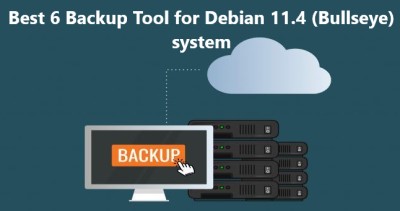Best 6 Backup Tool for Debian 11.4 (Bullseye) system
Debian SoftwareThere are several backup utilities available for Linux. Some of them are based on bash scripts and others are properly crafted open-source software. The problem comes when nothing is available in a default installation. To recover from some unexpected situations like human errors, Disk failure or RAID, Corruption of file systems, we need a good backup plan.
Here at IbmiSoft , we shall look into which backup tool is the best for Debian Linux system.
Features about an effective backup software includes:
- Cross-platform support – We need to ensure that backup software will work on all OS platforms on all desktop and server operating systems.
- Data format – We need to check that if It has an open data format that ensures that we can recover data if the vendor or project stopped.
- Auto-changers – Auto-changer is a backup device. They include a library, near-line storage also autoloader. Auto-changers allows us automatic loading task, mounting, and labeling backup media.
- Backup media – Before starting, we need to make sure about backup of our data in other external files.
- Encryption DataStream – We need to make sure all client-to-server traffic is encrypted.
- Database support – We need to make sure all backup software can backup database servers such as MySQL or Oracle.
Table of contents [Show]
1. Grsync
Grsync is primarily based on rsync, which is a command-line utility to perform a variety of backups. It has a simple user interface and beneath lies the full power of Rsync.
Grsync carries all the functionalities of any backup utility and this is the reason it is our first choice for any Linux distribution. Grsync can produce log files and save them externally. Log files can be used if anything goes wrong. It can be minimized to the system tray and run in the background. The greatest advantage Grsync carries is to pause the backup process.
To install Grsync, run the below command:
$ sudo apt install grsync
2. Duplicity
Duplicity is an exceptional backup tool. It can backup folders and files with differences only. What does that mean?
It is like if you have taken a backup already then Duplicity will simply backup changed files and folders in the future. It does not take new full backups which saves enormous time for the users.
Duplicity is a command-line tool and does not come with any graphical user interface. It is available on all major distributions repositories.
One of the greatest pros over the cons of Duplicity is that it also includes the rdiffdir utility. Rdiffdir is an extension of rdiff to directories which produces signatures of directories as well as files. Duplicity uses GPG keys. This way a user can make sure that files are always safe.
The greatest drawback of Duplicity is that it takes a lot of /temp/ space sometimes. This is an unavoidable drawback.
You need to run the following command to make a Duplicity backup:
$ duplicity ~/Documents . ~/home/user/backup
This will create a backup of the Documents directory to the backup folder in the user directory.
Duplicity can be downloaded from its website: http://duplicity.nongnu.org/docs.html
3. Clonezilla
Clonezilla is both backup software and a recovery tool. It can save and restore only used blocks on the hard disk. Clonezilla is used both for home computers and enterprise computers. It can create backup and recover 40-plus computers in one session.
Clonezilla is developed by NCHC Free Software Labs, Taiwan. It supports almost all of the file systems. The software is cross-platform, meaning it can run on whatever operating system you are using. It supports both MBR and GPT partition formats. Disk encryption is also supported and can be used easily. This is the reason we consider it a clear winner among all three tools.
Clonezilla is available on their website. https://clonezilla.org/downloads.php
4. Timeshift
Timeshift is a desktop utility it doesn’t do much for servers. However, it gives you superpowers to get a lot of things done. It can perform backups of different file systems. It will also create its BTRFS file system.
You can Install Timeshift from the available repository of your distribution.
To install Timeshift, run the below command:
$ sudo apt install timeshift
5. UrBackup
UrBackup is our last choice on this list. UrBackup does a great job when installed on Network. It is available for a variety of distributions. It syncs data from one network to another and provides exceptional backup service. It can be downloaded from the following link or you can look into the repositories to install it.
Download UrBackup from here https://www.urbackup.org/download.html PPAs are available for Ubuntu.
6. Time Vault
Time Vault is an Open Source Backup Software for Linux. It’s equivalent to Time Machine from Apple. It creates incremental backup files that can be restored at a later date. It can take snapshots, which can be stored in a directory at a certain point in time. These snapshots are very little spaced, so we need not entire backup files.
It's features include Creates incremental backups, Take a snapshot of the entire store as a backup, Creates more versions backed up data available for restoration, Nice looking graphical front end and The installation process is pretty straightforward.
You can get it here https://wiki.ubuntu.com/TimeVault
[Need help in installing Software in Linux system ? We can help you. ]
This article covers the different types of backup software you can use on Debian Linux system. In fact, Backup tools are a bridge connecting a server, client computer, or backup device with a data access point that is on another end. You would not want anything to go wrong while useful and sensitive data is passing through this bridge.



























